THE HUNTING SPIDERS
THE HUNTING SPIDERS
Last month's "Critters in Your Pond" explored the realm of our pond-side web-spinning spiders. As promised, in this issue we will peek into the lives of the hunting spiders, those who do not spin webs.

One of the first things I want to explain is that all spiders do spin silk, but some kinds of spiders do not make webs. There is the bolas spider that spins a single line of silk with a sticky drop at the end. When an insect flies near, the bolas swings the line and traps the insect on this sticky ball. However most Hunting Spiders run after insects (like that critter above) or lie in wait for them. In fact, some hunting spiders do spin simple webs that stretch out along the ground and stop insects. These spiders are also grouped as hunters because they run after the insects that land in their webs. Tarantulas with their poor vision use a system of silk lines going away from their nest to locate passing prey. Since hunting spiders have to run and capture their food, they mostly have large eyes so that they can see their prey from a distance. They have powerful chelicerae (see below) that help them overpower their victims. I think that right now is a good time for us to stop and take a look at a hunting spider's body:
Spiders have no bones. Their tough skin serves as their protective outer
skeleton. Spider's eyes are on top of and near the front of their head. The
size, number, and position of these eyes varies. Most species have eight
eyes, arranged in two rows of four each. Hunting spiders have good
eyesight for short distances. They need this to see their prey, while web
building spiders have poor eyesight as they do not need to see their prey
(relying instead on those `good vibrations' their struggling prey produce). A
spider's mouth is below its eyes. Spiders do not have chewing mouth parts,
as they eat only liquids! How is this you ask? Well, around the mouth
opening they have parts that form a short "straw" through which the spider
sucks the body fluid of its victim. Now, are you ready for this part? OK, this
is it: for the remaining parts, the spider sprays on some of its digestive
juices. In this manner, I read, a tarantula can reduce a mouse to a small pile
of hair and bones in about 36 hours. Oh my!
The Chelicerae are the pair of appendages that the spider uses to
seize and kill its prey. They are above the mouth and just below the eyes.
Each ends in a hard, hollow, pointed claw that are the spider's fangs (not
the palps like I used to think!). An opening in the tip of the fang connects
with the poison glands.  When a
spider stabs an insect with its chelicerae, poison flows into the wound and
paralyzes or kills the victim. I've found out that the palps actually are a pair
of appendages that look like small legs and are used to hold things, sort of
like arms.
When a
spider stabs an insect with its chelicerae, poison flows into the wound and
paralyzes or kills the victim. I've found out that the palps actually are a pair
of appendages that look like small legs and are used to hold things, sort of
like arms.
Here are some of the main types of hunting spiders:
Jumping spiders
creep up and pounce on their prey. These
spiders have short legs, but they can jump more than 40 times the length of
their bodies. Jumping spiders are the most colorful of all spiders. You're
most likely to see them around your pond deck or on the rocks around the pond.
Water Spiders are the only spiders that live most of their lives underwater. The spider breathes under water from air bubbles that it holds close to its body. Its underwater nest is a silk web shaped like a small bell. The spider fills the web with air bubbles, which gradually push all of the water out of the bell. The animal can live on this air for several months. However, water spiders are found only in Europe and parts of Asia. So unless your pond is there, you won't find one in yours.
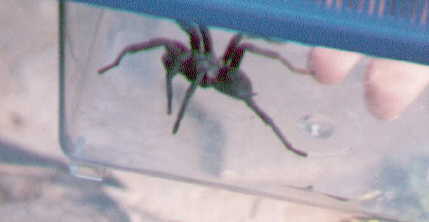 Tarantulas are the
world's largest spiders. Great numbers of tarantulas are found in the
Southwestern United States, although I found this one beside my pond, here
in Northern Calif. To read more about my adventure with it, click here. Many
kinds of tarantulas dig burrows as
nests. The trap-door spider covers the entrance to its burrow with a lid. A
California tarantula builds a turret (small tower) of grass and twigs at the
entrance to its burrow. This spider then sits on the tower and watches for
insects moving in the nearby grass. A few kinds of tarantulas live in trees.
Tarantulas are hairy and come in many colors such as
black, brown, or red. Some people like to keep tarantulas as pets and
some females have lived 20 years in captivity!
Tarantulas are the
world's largest spiders. Great numbers of tarantulas are found in the
Southwestern United States, although I found this one beside my pond, here
in Northern Calif. To read more about my adventure with it, click here. Many
kinds of tarantulas dig burrows as
nests. The trap-door spider covers the entrance to its burrow with a lid. A
California tarantula builds a turret (small tower) of grass and twigs at the
entrance to its burrow. This spider then sits on the tower and watches for
insects moving in the nearby grass. A few kinds of tarantulas live in trees.
Tarantulas are hairy and come in many colors such as
black, brown, or red. Some people like to keep tarantulas as pets and
some females have lived 20 years in captivity!
Fisher Spiders live near water and hunt water insects, small fish, and tadpoles. These spiders have large bodies and long, thin legs. But because of their light weight, they can walk on water without sinking. They also can dive underwater for short periods of time. Some fisher spiders are called nursery-web weavers because the female builds a special web for her young.
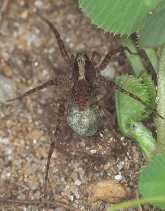 Wolf Spiders are very
common around our ponds and are excellent hunters.
Wolf Spiders are very
common around our ponds and are excellent hunters. 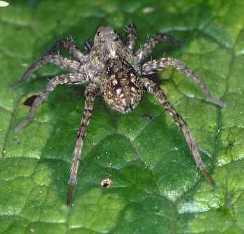 Many kinds have large, hairy bodies, and
run swiftly in search of food. Others look and act like other types of spiders.
For example, some live near water and resemble fisher spiders in appearance
and habits, often running across the water surface, like this one on a lily pad at
Alan Farmer's pond (below). Others live in burrows, or spin funnel-shaped
webs. They like to eat each other and are pretty fast. Large wolf spiders can
live several years.
Many kinds have large, hairy bodies, and
run swiftly in search of food. Others look and act like other types of spiders.
For example, some live near water and resemble fisher spiders in appearance
and habits, often running across the water surface, like this one on a lily pad at
Alan Farmer's pond (below). Others live in burrows, or spin funnel-shaped
webs. They like to eat each other and are pretty fast. Large wolf spiders can
live several years. 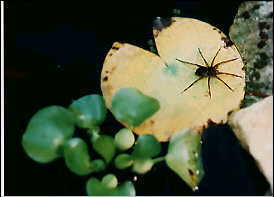
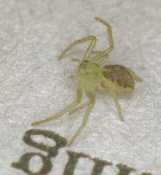 The Crab Spiders are
among my personal favorites. They are easily recognizable because if you disturb
them, then they widen their legs and move side ways like a crab. They are
usually 4 - 10 mm. They are not active hunters and they make more use of
camouflage techniques than other spiders. The color of each individual spider is
adapted to its hunting terrain and is often quite extravagant. Crab spiders remain
motionless until their prey arrives and then they reach out and catch it. The front
two legs, which are often larger and stronger than the other six, are held
sideways, ready to catch any prey immediately.
The Crab Spiders are
among my personal favorites. They are easily recognizable because if you disturb
them, then they widen their legs and move side ways like a crab. They are
usually 4 - 10 mm. They are not active hunters and they make more use of
camouflage techniques than other spiders. The color of each individual spider is
adapted to its hunting terrain and is often quite extravagant. Crab spiders remain
motionless until their prey arrives and then they reach out and catch it. The front
two legs, which are often larger and stronger than the other six, are held
sideways, ready to catch any prey immediately. 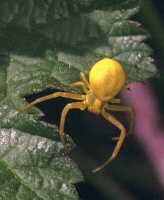 With a poisonous bite (which is not dangerous to humans) they kill
their prey and suck it dry. They can often be found on the flowers or leaves of
plants around our ponds and elsewhere. Often one crab spider can remain for
days or even weeks at the same spot. They normally have two big front eyes and
their eyesight is excellently developed. This crab spider to the right can adapt its
color to it surrounding. The color of its body can change from snow white to egg
yolk yellow to green. The change of color takes 2-3 days. Its main diet is bees. If
he/she is lucky and catches a lot of prey, then it hangs its surplus stock below its
hiding place!
With a poisonous bite (which is not dangerous to humans) they kill
their prey and suck it dry. They can often be found on the flowers or leaves of
plants around our ponds and elsewhere. Often one crab spider can remain for
days or even weeks at the same spot. They normally have two big front eyes and
their eyesight is excellently developed. This crab spider to the right can adapt its
color to it surrounding. The color of its body can change from snow white to egg
yolk yellow to green. The change of color takes 2-3 days. Its main diet is bees. If
he/she is lucky and catches a lot of prey, then it hangs its surplus stock below its
hiding place!
Those are the main types of hunting spiders. Keep your eyes open around
your pond and see how many of these types you can find.
Remember that all spiders have fangs, and most kinds of spiders have poison glands. Spiders use their fangs and poison glands to capture animals for food. A spider's bite can kill insects and other small animals. Some tarantulas can even kill birds! However, only a few kinds of spiders are harmful to humans. In North America, around six kinds of spiders have bites that can harm people badly. Some of these are the brown recluse spider, the brown widow, the red widow, the black widow, the lynx spider, and a few others. Luckily almost all of these spiders are quite shy (in Australia some are quite aggressive!). So enjoy your arachnids, remember that they are busy eating those mosquitoes and other `varmints' who insist on sharing our ponds, and therefore deserve our kind consideration.
Ed Nieuwenhuy of the Netherlands' cool Spider Pages
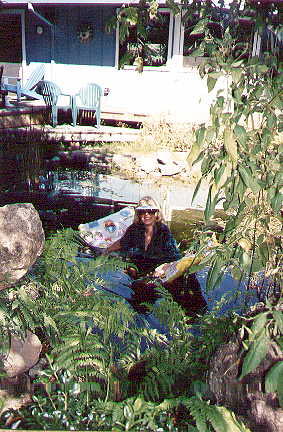 Kathy INSISTS that this picture of
her "Better Side" be included after the editor (Pam Ingle) sneakily included her
"less than best" side snapshot last month. Kathy also wishes each and every
one of you a wonderful Thanksgiving (she's thankful for all the feedback you
give her) and a joyous holiday season.
Kathy INSISTS that this picture of
her "Better Side" be included after the editor (Pam Ingle) sneakily included her
"less than best" side snapshot last month. Kathy also wishes each and every
one of you a wonderful Thanksgiving (she's thankful for all the feedback you
give her) and a joyous holiday season.